American Society for Quality
Annual Quality Congress
May 5, 1998
Richard E. Winder, J.D., M.B.A.
Daniel K. Judd, Ph.D.
Copyright, 1998, Richard E. Winder and Daniel K. Judd. All Rights Reserved.
SUMMARY
Understanding physical, metaphysical, and dynamic levels of existence assists in
building systems and habits that respond to underlying dynamics. This compass, map, and
course framework is evident in the models of Deming, Covey, and Senge, and can creatively
integrate their models in a universal model for personal and organizational development.
KEY WORDS
Aim-Plan-Do-Study-Act Cycle; Compass, Map, and Course Framework; Creativity; Five
Dimensions of Quality
INTRODUCTION
A legal foundation assisted a group of legal services providers (non-profit law
firms which provide free legal services to the poor) in establishing an e-mail network.
This network, developed in response to a survey of technology-related needs of the Legal
services providers, provided a means for any legal services advocate to communicate with
any other advocate in the system. The focus of this project was to facilitate sharing of
information among legal services staff. For example, an attorney with a matter having a
unique legal issue could e-mail other attorneys regarding the issue and receive, by return
e-mail, documents and forms to assist him or her in preparation of the case.
As the project developed, it was discovered that another major, unanticipated
positive impact of the e-mail system was the increased comradery developed among advocates
within and between offices. As it turned out, a major benefit of the system was its
ability to facilitate advocates and staff in "keeping in touch" with each other
in a creative manner previously not available.
A poem by Robert Frost reads: "Two roads diverged in a yellow wood.... And I took
the one less traveled by, And that has made all the difference." One point of this
poem is simple and yet profound: the choices we make in the present will have a
significant impact on our future as individuals and the future destinations of our
organizations. Some of these choices will affect our organizations in ways that we do not
now understand.
Realizing the gravity of our decisions on the future of our organizations, sometimes we
shy away from decisions, particularly those involving innovations, or deviations from our
standard methods of operation. As noted by Whyte (1994), "Take any step toward our
destiny through creative action and we know intuitively that we are giving up whatever
lever we had, and we tend to back away from the moment." Since we do not know the
future, how can we make creative decisions in the present which will make the future
predictable--decisions which will secure the future of our organizations? What framework
can we use to make sound decisions about the future of our systems?
The answer to these questions is really quite elementary: we simply make decisions in
the context of the dynamics which underlie the conduct we see or seek.
Although the answer to these questions is simple, the application of the process of
making decisions in context is quite complex because often we do not recognize or
understand the dynamics of the environment in which we are operating. When we find
ourselves realizing that things are not what they appear to be, then we need to ask
ourselves whether the things that we observe are what we assumed they were, or whether
they are manifestations of something quite different. We assume that what we observe is
what it appears to be, without realizing that our perception is affected by our paradigm,
and without querying whether what we see is actually a manifestation of something deeper
and more complex than we see on the surface. As we learn to recognize the dynamics of the
environment in which we operate, we can actually apply that insight to creatively shaping
the system that will take us into the future.
Midway through the e-mail project, the technology committee which had developed and
implemented the e-mail project was given the charge of reviewing and recommending a
software package to track legal services attorneys' time, as required by new federal
regulation. The committee resisted the temptation to recommend a stand-alone timekeeping
package, realizing that to do so would be implementing a "band-aid" approach
that would not fully integrate the legal services programs' information needs and would
actually fragment the data management process. The committee also resisted the tendency to
use a software package designed specifically for legal services because the narrow market
for that software raised service and support issues.
The software which the committee recommended was a mainstream law office package
that was adapted to the special data and reporting requirements of legal services. The
software provided comprehensive timekeeping, case management, docket control, document
generation, conflicts checking, and database replication capabilities. Within a month
after the recommendation was made by the committee it was reinforced by a Law Office
Computing magazine article which gave the case management software the highest rating
of nine top case management packages reviewed. Yet the decision to recommend the software
was criticized by some because of its cost, its operating system requirements, and because
of the deviation from using the specialized legal services software.
The challenges to this decision triggered further analysis, which eventually
brought the technology committee to the realization that a much deeper dynamic was
involved in the decision: Since the software is a mainstream law office package, its data
replication and transfer capabilities can be used to electronically transfer case
information for some client matters (which the legal services program could not handle for
various reasons) to private attorneys who would handle the matters on a pro bono
basis (with no charge to the client).
But the dynamic extended even further: just as the e-mail system had resulted in an
unforseen building of social interaction among legal services advocates, the case
management software and training which would be provided by the legal services support
group would permit a similar interface with attorneys in private practice. While in the
past some legal services programs were somewhat isolated from the private bar and bar
association activities, they could now develop an integrated interface with that bar,
permitting a greater level of interaction--and an expansion of the resource of private
attorneys willing to handle cases without charge.
The recognition of this dynamic solidified the case management decision. The impact
of that decision will not be known for several years, but based on the e-mail experience,
it is expected that those legal services programs which utilize the mainstream law office
software will enjoy a much better interface with the private bar than those which retain
their isolated legal services software.
TEXT
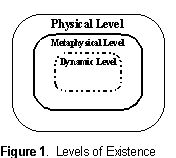 Our personal and
organizational activities exist on three fundamental planes, or levels of existence: a
physical plane, a metaphysical plane, and a dynamic plane (see Figure 1). The physical
plane is the level of existence we can experience and observe. The metaphysical plane
exists beyond, or transcends, the physical plane and attempts to supply meaning to
physical occurrences. The dynamic plane relates to the physical, social, intellectual, or
moral forces that produce activity or change in a system. We observe this activity or
change at the physical level, and we interpret it at the metaphysical level. While we are
generally aware of the physical, we are often less aware of the metaphysical meaning and
dynamic forces. Yet those two planes are integrally connected with the physical existence
and have a very real impact on it. If these planes are not understood, then unexplained,
unintended, and even unknown consequences may occur at the physical level.
Our personal and
organizational activities exist on three fundamental planes, or levels of existence: a
physical plane, a metaphysical plane, and a dynamic plane (see Figure 1). The physical
plane is the level of existence we can experience and observe. The metaphysical plane
exists beyond, or transcends, the physical plane and attempts to supply meaning to
physical occurrences. The dynamic plane relates to the physical, social, intellectual, or
moral forces that produce activity or change in a system. We observe this activity or
change at the physical level, and we interpret it at the metaphysical level. While we are
generally aware of the physical, we are often less aware of the metaphysical meaning and
dynamic forces. Yet those two planes are integrally connected with the physical existence
and have a very real impact on it. If these planes are not understood, then unexplained,
unintended, and even unknown consequences may occur at the physical level.
For example, Deming spoke of the company which had a very strict bereavement policy
which required extensive documentation for three days' bereavement leave. At one point the
firm realized that the policy was drafted with very strict requirements to ensure that
employees did not abuse the policy. However, they also realized that most of their
employees would not attempt to abuse bereavement leave privileges. So they modified the
policy to permit employees to more freely take bereavement leave upon approval of their
supervisor. The incidence of bereavement leave (the number of times bereavement leave was
taken) increased dramatically. However, the number of days actually taken decreased by
47%.
Under both policies there were dynamic forces which had an impact on the behavior of
the system. These forces affected or contributed to the actions of the employees and
management under the system. As the firm recognized the existence of these forces,
identified what they were, and modified its bereavement "system" to more
effectively align the policy with the trusted nature of its employees, it found that the
additional benefits it provided for employees had a serendipitous positive impact on the
firm as a whole. The change in the system seemed contrary to the result one would
expect--one would expect an increase in total time off work upon a loosening of the
policy. Yet the action of the system was sound in the metaphysical context: it was
explained in terms of the trustworthiness of the employees and the trust which the firm
placed in its employees.
THE MAP & COMPASS FRAMEWORK
The focus of this paper is provide a framework to assist individuals and organizational
leaders to 1) recognize the existence of dynamic forces and metaphysical meaning
underlying their personal lives and organizational systems; and to 2) more effectively
utilize these underlying forces in their personal lives and in the structure and operation
of their systems. The approach proposed here goes beyond simply focusing on the paradigm
or the principles relating to the paradigm. For example, at one level, we could say that
we should build a trusting environment in our organizations and personal relationships,
recognizing that principles of trust are important in an organization. The Map &
Compass approach goes deeper, to the dynamics underlying that environment so that we
understand, for example, why the trusting environment is productive. As we move to
a deeper level of understanding than the physical level of existence provides, we find
that the mapping functions help us observe the metaphysics and principles of the
environment in which we travel. In addition, the compass functions help us discern
direction ascertained from invisible dynamic forces.
The Map & Compass framework is the metaphysical and dynamic elements of the
Orienteering Model--the integrated use of a compass and map to travel a course, checking
in at control points (Winder and Judd, 1996). The focus of the Map & Compass framework
is not on the physical level (the "Course," or what we can see and observe).
Quality literature is replete with the elements of the course--experience, measurement,
systems, and continuous improvement within the system. Rather, the focus of this model is
on what underlies the physical level--the paradigms and dynamics which go into making the
physical level what it is. It is this level that gives us the opportunity for quantum leap
improvement, as we uncover dynamics that permit us to change the very nature of systems
(as opposed to simply improving the existing system) and to build systems responsive to
those dynamics. This is the level that Senge (1990), Barker (1992), and Covey (1993)
address.
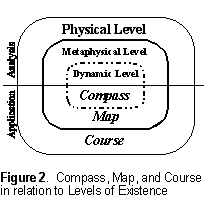 The Map and
Compass Framework moves us from an analysis mode to an application mode (see Figure 2). It
helps us not only evaluate existing conditions, but permits us (with an understanding of
those conditions) to develop innovative prospective applications that incorporate our
learning.
The Map and
Compass Framework moves us from an analysis mode to an application mode (see Figure 2). It
helps us not only evaluate existing conditions, but permits us (with an understanding of
those conditions) to develop innovative prospective applications that incorporate our
learning.
In the analysis mode we move from what we see and observe (the physical level) to our
interpretation (the metaphysical level) of the reason for the behavior (the dynamic level)
of what we observe. In the Map & Compass framework, we invert the process. We first
view the dynamics, and let them shape our interpretation, without pre-conceived notions of
what the dynamics mean. This permits us to think "out of the box," so that we
are not just tinkering with existing systems, but are instead reengineering the system
from whatever level is needed to incorporate the dynamics. We then build or restructure
systems, processes, and habits that are responsive to those dynamics. For this reason, the
Map & Compass framework engenders creativity and innovation in personal and
organizational development. Innovation is the process of perceiving and understanding
dynamics (at the Compass level) and the designing systems that respond to those dynamics
(at the Map level), eventually implementing these systems in the organization (at the
Course Level).
In order to understand and apply the Map & Compass framework, it is essential to
understand the nature of dynamics and metaphysics, and their influence on the physical
level of existence that we experience and observe.
The Compass: The Dynamic Level of Existence
Dynamics are at the heart of organizational existence. If understood, they can provide
a perception of the environment which is essential to organizational health. Just as a
compass responds to invisible forces to point direction, Compass principles help assess
the invisible forces of the dynamics that are all around us and provide direction to us
and our organizations. In the movie Volcano, it was the geologist's perception of
the unseen dynamics of the lava flow through the subway tunnel that provided the basis for
the Office of Emergency Management to take action to dig a channel and topple a building
in order to avert an even greater disaster.
In the modern world, organizations are in business to serve customers, members, and
other constituents. The needs of customers are the organization's reason for being. The
way in which organizational leadership views the dynamics of customer needs will affect
the structure of the systems the organization puts in place to serve the customers. In
fact, it is at the dynamic level that vision is born, because vision is the linking of the
needs of the customer with the resources of the organization (Winder and Judd, 1996). At
the personal level, it is the desire to make a contribution to a common endeavor that
provides purpose (vision) for the individual. Dynamics have a significant impact on the
relationships that are built with the constituents of the organization.
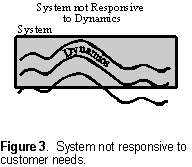 Dynamics provide
overriding purposes, or unifying benefits which can guide personal and organizational
development. Intuitive response to needs-fulfillment and effective response to relational
dynamics can build a much more solid foundation for "sustaining membership" of
customers and employees than reaction to these dynamics. For example, Jim Graley, who
owned a typical auto body repair shop which was unfriendly to women (see Figure 3),
responded to the dynamic that women are the key decision makers in 70% of new car
purchases by modifying his systems and processes to attract the business of women (see
Figure 4), tripling his sales in one year (from $525,000 to $1.6 million). (Conlin, 1992).
Dynamics provide
overriding purposes, or unifying benefits which can guide personal and organizational
development. Intuitive response to needs-fulfillment and effective response to relational
dynamics can build a much more solid foundation for "sustaining membership" of
customers and employees than reaction to these dynamics. For example, Jim Graley, who
owned a typical auto body repair shop which was unfriendly to women (see Figure 3),
responded to the dynamic that women are the key decision makers in 70% of new car
purchases by modifying his systems and processes to attract the business of women (see
Figure 4), tripling his sales in one year (from $525,000 to $1.6 million). (Conlin, 1992).
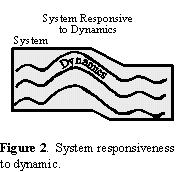 Since vision is based on
linking needs with resources, and since needs and resources are in a constant state of
change, vision itself is always changing. Consequently, it is important to always monitor
the dynamics to ensure that systems and processes are still in alignment with and support
the unifying purposes of the organization. Moreover, the organization must ensure that its
systems and processes nurture relationships with key constituents, including customers,
employees, and owners. If those constituents are part of the vision process, and are
included in the unifying purposes used by the organization, then it is likely that the
systems and processes which are developed will incorporate their needs.
Since vision is based on
linking needs with resources, and since needs and resources are in a constant state of
change, vision itself is always changing. Consequently, it is important to always monitor
the dynamics to ensure that systems and processes are still in alignment with and support
the unifying purposes of the organization. Moreover, the organization must ensure that its
systems and processes nurture relationships with key constituents, including customers,
employees, and owners. If those constituents are part of the vision process, and are
included in the unifying purposes used by the organization, then it is likely that the
systems and processes which are developed will incorporate their needs.
Dynamics themselves follow the Five Dimension pattern (see Chart 5) developed by
Winder, Robison, and Judd (Winder, 1993). At the first dimension experience level they may
seem like random forces or influences which have no bearing on the success of an
organization. A closer study at the second dimension level may reveal patterns which are
consistent in repeat occurrences (see Wheatley, 1992). As patterns emerge, they may form
into broader trends at the third dimension relationship level. At this point, public
awareness of the dynamic patterns is increased, and markets are developed. Jim Graley's
insight into the focus on women as key decision makers came at a time when a pattern had
been established through research by General Motors of their customer purchase data, but
perhaps prior to development of clear trends. In fact, it is people like Jim Graley, who
recognize and creatively respond to dynamic patterns, that move the dynamics to a trend by
implementing systems based on those patterns and thereby increase public awareness of the
patterns. Moreover, firms which recognize dynamics and patterns prior to the time they
become trends are considered innovators, and they have a distinct advantage in market
development and in capturing and holding market share.
At the fourth dimension interconnectivity level, dynamics form themselves into
archetypes described by Senge (1990). At this level, the focus is on "patterns of
patterns," or common types of recurring patterns that can be observed in a wide range
of situations. At the fifth dimension value sharing level, dynamics form structures, or
complete systems of dynamics that are all inter-related. Since we operate within these
structures, it is difficult for us to even recognize that they exist; yet they have a real
impact on the organization and the environment in which it exists. An example of a
structure is the relational pattern described in the case management software
implementation noted above. While the focus of the software was to assist legal services
advocates, its data replication capabilities provide a powerful tool for improving legal
services advocates' relationships with the private bar, creating an impact equally as
great as the quest for efficiency.
We see a similar pattern in organizational development and in the stages of business
growth (Churchill and Lewis, 1983). At the experience level, the focus of the organization
is on existence. Then it turns to survival, as the organization sees purchasing patterns
that will support the organization and uses these to build the business. As the
organization is able to implement systems to ensure consistency in service to its
constituents, it reaches a success stage. Then growth ensues as it sees its place in a
broader community and begins to partner with others, including its constituents. Finally,
the pinnacle is a level of maturity, where the organization becomes a significant
contributor to the broader community and has reached a level of existence that is almost
self-perpetuating.
The Map: The Metaphysical Level of Existence
Dynamics are very powerful forces that can be utilized in personal and organizational
growth and development. However, dynamics are worthless--even dangerous--if they are not
recognized and understood. It is metaphysics that gives us the ability to see the
dynamics and then build systems that are responsive to the dynamics. Metaphysics--referred
to by Winder (1993) as Fourth Dimension Interconnectivity or Paradigm Logic--are the
eyeglasses through which we can observe the dynamic forces underlying our organizational
systems. Our paradigms are the maps, or mental models (Senge, 1990) through which we
interpret our environment and travel in it. Because our perception is influenced by our
paradigm, it is very difficult in our measurement of our systems to think beyond the
limitations of the system. Consequently, like Jim Graley (prior to his insight), we may
ignore important dynamics that are very important to our customers. Our measurements, for
the most part, are designed to measure what is internal to our system to ensure that the
system is working, rather than external forces that might have an impact on the system.
Through metaphysics we turn our focus to the broader environment in which we exist.
Metaphysics literally means "beyond the physical"--thinking beyond what can be
scientifically observed. Consequently, metaphysical thinking may not seem logical in the
context of the existing perception of the environment, but when understood in the context
of the dynamic forces at play can lead to innovative, enlightened decisions that move the
firm forward in ways not otherwise possible. For example, John McCormack's decision to raise
prices and engage in an extensive advertising campaign for his hairdressing salons at the
beginning of a recession seemed rather inappropriate to others until they saw his Visible
Changes sales and revenues increase. It was his experience as a stockbroker that helped
him "think out of the box" and prepare for the recession by recognizing
indicators of a recession through observation of such factors as oil industry activities
and sales of mens clothing. (Posner and Burlingham 1988).
The Course: The Physical Level of Existence
Because we spend our time in the physical level of existence, we are most familiar with
it. The physical plane contains the tangible systems that provide our interface with our
constituents. These include the actions, measurements, and systems and processes through
which we serve our customers and other constituents. Ideally our experience is captured in
our system through a process of continuous improvement. However, this improvement process
alone is insufficient to permit us to maintain our market edge if we are not always in
tune with customer needs and if we are not constantly incorporating those needs into the
system.
The physical plane is the course we choose to pursue in our relationships with our
constituents. It is our external "surface structure" or delivery system. It
reflects the Do-Study-Act phase of Deming's Aim-Plan-Do-Study-Act Cycle. It may or may not
follow an underlying plan or purpose. It may, in fact be a serendipitous discovery or a
copy of a system or plan developed or used by others (such as a standard industry
application or a franchise outlet).
THE ORIENTEERING MODEL
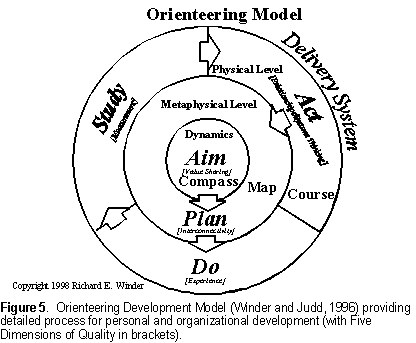 The Orienteering Model
(Winder and Judd, 1996) presupposes a flow to the interaction of dynamics, metaphysics,
and physical activities (see Figure 5). This flow follows Deming's Aim-Plan-Do-Study-Act
Cycle (Deming, 1993, did not specifically add "aim" to the Plan-Do-Study-Act
Cycle, but indicated that every system must have an aim; the addition of
"aim" to this cycle brings it into complete alignment with the Five Dimensions
of Quality and the Orienteering Model). The flow model is comprehensive in design, but may
be incomplete in application. For example, an organization may design a system and put it
into place without piloting it or testing it to ensure their assumptions about the
dynamics were correct (this is the Plan-Act cycle). Or, an organization may simply
discover that what it has done (without any planning) actually works, and then implement
it (the Do-Study-Act cycle).
The Orienteering Model
(Winder and Judd, 1996) presupposes a flow to the interaction of dynamics, metaphysics,
and physical activities (see Figure 5). This flow follows Deming's Aim-Plan-Do-Study-Act
Cycle (Deming, 1993, did not specifically add "aim" to the Plan-Do-Study-Act
Cycle, but indicated that every system must have an aim; the addition of
"aim" to this cycle brings it into complete alignment with the Five Dimensions
of Quality and the Orienteering Model). The flow model is comprehensive in design, but may
be incomplete in application. For example, an organization may design a system and put it
into place without piloting it or testing it to ensure their assumptions about the
dynamics were correct (this is the Plan-Act cycle). Or, an organization may simply
discover that what it has done (without any planning) actually works, and then implement
it (the Do-Study-Act cycle).
The critical underlying assumption of the Map & Compass framework of the
Orienteering model is that organizations which use the complete model and utilize the
compass and map functions to plan based on underlying dynamics will have a more secure
future than those who do not. James M. Higgins noted that a good innovation system cuts
across all four areas of creativity--product, process, management, and marketing (Martin
and Voehl, 1998). Product and process are physical level functions, but innovations in
this area are incomplete if they do not also integrate management paradigms (metaphysical
level functions) and market-driven customer-focused vision, which links the resources of
the organization with the needs of the customer (dynamic level functions).
The other side of this coin is that organizations which in the past have tended to back
away from innovative decisions can now have some certainty in their decision making. This
certainty is based on an understanding of where the dynamics will take them. In other
words, they do not need to rely on proven results before taking action. They can postulate
the end result based on the dynamics they observe in the present. This permits them to
move ahead with innovation and creativity, rather than simply relying on the "wait
and see" attitude that keeps them from "capturing the moment." This concept
is essential to understanding and effectively using concepts of prediction outlined by
Deming (1993) in the Knowledge component of his Theory of Profound Knowledge. This concept
can assist organizations in capturing markets and customers rather than losing them to
competitors.
The case management project noted above is brimming with the innovative use of
prediction based on underlying dynamics related to interaction of legal services staff
with the private bar. The full impact will not be known for several years. But initial
assessment of dynamics through surveys of the members of the State Bar of Michigan (see
Roberts, 1997) and input from experts provides a foundation for moving ahead with a pilot
project to test these assumptions. The value of the pilot is that it permits focused
testing of dynamic assumptions prior to full-scale implementation. If the pilot is
successful, the statewide project will proceed. If not, the experience gained will provide
greater insight as to the actual dynamics, which can then be used in evaluating and
developing future projects. As the pilot project is being implemented and unforseen
obstacles have arisen, it is becoming clearer that the easiest course would have been to
adopt a case management package specifically designed for legal services offices. But what
keeps driving the project is not only the efficiencies it is creating, notwithstanding the
obstacles, but also the vision of linking with the entire resource of the private bar.
Iterative Application of the Orienteering Model
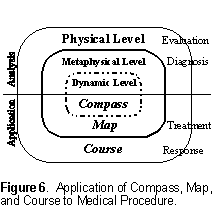 As near as the authors
can tell, the Orienteering model and its Map & Compass framework is a universal model
that provides a comprehensive tool for creative personal and organizational development.
Its power comes from the fact that it is based on fields of meaning related to the Five
Dimensions of Quality and the Compass, Map, and Course flow structure of those dimensions.
As a consequence, the model can be used repetitively in multiple iterations, simply by
supplying other words or concepts within the field of meaning.
As near as the authors
can tell, the Orienteering model and its Map & Compass framework is a universal model
that provides a comprehensive tool for creative personal and organizational development.
Its power comes from the fact that it is based on fields of meaning related to the Five
Dimensions of Quality and the Compass, Map, and Course flow structure of those dimensions.
As a consequence, the model can be used repetitively in multiple iterations, simply by
supplying other words or concepts within the field of meaning.
For example, the medical process of evaluation-diagnosis-treatment-response utilizes
both the analysis and the application functions of the Map and Compass Framework (see
Figure 6). Evaluation, a physical level function, actually involves the three dimensions
of quality that are a part of the physical level of existence: observation (experience),
evaluation (measurement), and pattern recognition (relationships). Diagnosis relies on the
doctor's expertise (experience gained through training or practice) to understand how the
items observed in the evaluation relate to the dynamics of a particular illness or injury.
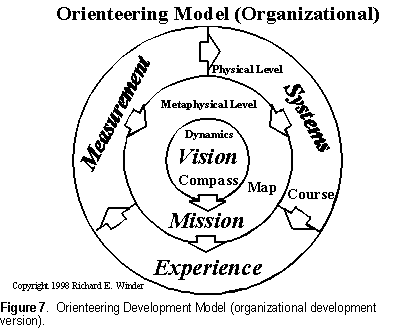 The accuracy of the
diagnosis will have an impact on the value of the treatment, which also relies on the
medical expertise of the doctor to "Map" a treatment that (based on the doctor's
understanding of the dynamics) is geared toward assisting in the healing process, at least
for curable diseases or injuries. Finally, it takes actual implementation of the treatment
plan (traveling the Course) to determine the response of the patient and to assess whether
the doctor's assessment of the injury/illness and the treatment were effective.
The accuracy of the
diagnosis will have an impact on the value of the treatment, which also relies on the
medical expertise of the doctor to "Map" a treatment that (based on the doctor's
understanding of the dynamics) is geared toward assisting in the healing process, at least
for curable diseases or injuries. Finally, it takes actual implementation of the treatment
plan (traveling the Course) to determine the response of the patient and to assess whether
the doctor's assessment of the injury/illness and the treatment were effective.
Organizational Model. The universal nature of the Orienteering
Model permits its use in the personal as well as the organizational context. Figure 7
shows the application of the Orienteering Model in the organizational context. Vision
which links needs of customers with organizational resources is at the heart of
organizational existence and provides the unifying purposes which unite customers with
organizations. With this vision in mind, the organization develops a mission in order to
map the strategies it will use to fulfill needs in the markets it chooses to pursue. This
is then put into place in a delivery system, in which the firm develops experience,
measures its progress against landmarks or control points, and puts into place systems to
ensure its interactions with customers are consistent and effective.
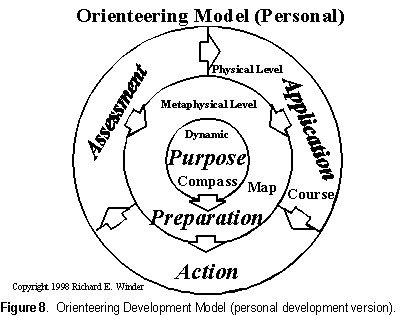 Personal Model. Figure 8 shows the application of
the Orienteering Model in the personal context. At the core of the personal model is the
individual's purpose, which arises from the person's ability to contribute to one or more
functions or enterprises. The mapping stage at the individual level involves
preparation--gaining needed education or experience to expand the person's frame of
reference to recognize patterns or dynamics and to formulate ways to contribute. The
course then becomes one of action (doing as planned), assessment (evaluating progress),
and application (developing habits or programs to support the desired behavior on a
long-term basis).
Personal Model. Figure 8 shows the application of
the Orienteering Model in the personal context. At the core of the personal model is the
individual's purpose, which arises from the person's ability to contribute to one or more
functions or enterprises. The mapping stage at the individual level involves
preparation--gaining needed education or experience to expand the person's frame of
reference to recognize patterns or dynamics and to formulate ways to contribute. The
course then becomes one of action (doing as planned), assessment (evaluating progress),
and application (developing habits or programs to support the desired behavior on a
long-term basis).
INTEGRATING DEMING, COVEY, AND SENGE
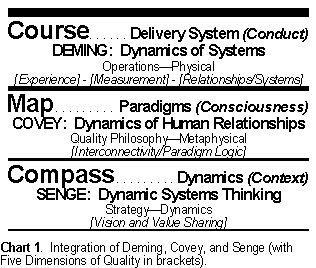 The models developed
by Deming, Covey, and Senge are complete models which represent some of the best thinking
of the Twentieth Century related to organizational development. Their models can be used
effectively in an organization, and in fact they are used pervasively in many
organizations. Application of any one of the models can produce desirable results.
The models developed
by Deming, Covey, and Senge are complete models which represent some of the best thinking
of the Twentieth Century related to organizational development. Their models can be used
effectively in an organization, and in fact they are used pervasively in many
organizations. Application of any one of the models can produce desirable results.
If the Orienteering Model is a universal model, then not only can it be applied in both
the personal and organizational context, it can also be applied repetitively to the models
developed by Deming, Covey, and Senge to provide a framework for understanding how their
models relate with one another. This iterative process can also identify where their
models fit in a universal framework.
As noted in Chart 1, Deming, Covey, and Senge each fulfill a distinct part of the
Orienteering Model. 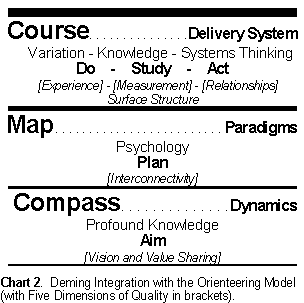 Deming's
focus was on the physical level--the course. His interest was in the delivery system and
how understanding systems and variation can assist in knowing the capacity of the system.
Covey's focus is on the metaphysical--the map--including the principles of human
relationships, and how the improvement of those relationships can improve the
organization. Senge's focus is on the compass--the unseen but very powerful dynamics
underlying systems. A focus on these dynamics and the structures that cause activity
within a system can assist in the strategic planning process in determining what markets
should be pursued and what skills should be developed. It is our consciousness of
the dynamic context of our environment that permits us to shape the conduct
of our systems.
Deming's
focus was on the physical level--the course. His interest was in the delivery system and
how understanding systems and variation can assist in knowing the capacity of the system.
Covey's focus is on the metaphysical--the map--including the principles of human
relationships, and how the improvement of those relationships can improve the
organization. Senge's focus is on the compass--the unseen but very powerful dynamics
underlying systems. A focus on these dynamics and the structures that cause activity
within a system can assist in the strategic planning process in determining what markets
should be pursued and what skills should be developed. It is our consciousness of
the dynamic context of our environment that permits us to shape the conduct
of our systems.
Not only did Dr. Deming emphasize the use of the Aim-Plan-Do-Study-Act cycle, he built
his Theory of Profound Knowledge (Deming, 1993) around a similar structure. The four parts
of his Theory of Profound Knowledge correspond with the first four of the Five Dimensions
of Quality in the Orienteering Model. (See Chart 2). Variation is an experience level
function which exists in any system. Knowledge is a measurement function. 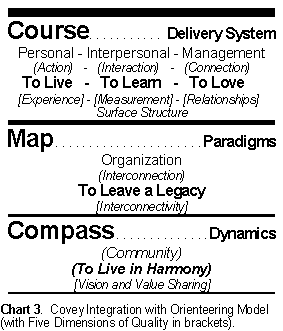 It is said that we can learn
from experience, but the truth is that our learning is not based on experience itself, but
our reflection on experience. Moreover, it is knowledge of the dynamics underlying systems
that gives us the ability to predict the future with some certainty. Systems are a
relationships and systems thinking function. They permit standardizing the course so that
it can be repeated on a consistent basis. Psychology is a paradigm function. It is a shift
in paradigms which will permit an organization to see the difference between intrinsic and
extrinsic rewards, and the residual effects of each type of reward system.
It is said that we can learn
from experience, but the truth is that our learning is not based on experience itself, but
our reflection on experience. Moreover, it is knowledge of the dynamics underlying systems
that gives us the ability to predict the future with some certainty. Systems are a
relationships and systems thinking function. They permit standardizing the course so that
it can be repeated on a consistent basis. Psychology is a paradigm function. It is a shift
in paradigms which will permit an organization to see the difference between intrinsic and
extrinsic rewards, and the residual effects of each type of reward system.
In a number of ways, Covey's teachings have four components, corresponding to the first
four of the Five Dimensions of Quality in the Orienteering Model (see Chart 3). (Covey,
1993). The four basic human needs directly correspond with these dimensions. The need to
live is an experience level function. The need to learn is a measurement or knowledge
function. The need to love is a relationship function. The need to leave a legacy is a
paradigm function. These all integrate with building and sustaining relationships. Covey's
personal, interpersonal, management, and organization concepts requiring trustworthiness,
trust, empowerment, and alignment provide a human relations dimension of action (experience),
interaction (measurement, "what can I contribute" and "what can I
use"), connection (systems and relationships, involving individual's
contribution to the team such that the power of team is greater than that of the
individuals separately), interconnection (permitting us to see things through
"different eyes," and expand our paradigm or frame of reference), and
community (greater vision and heightened sensitivity to our surroundings and
greater awareness of the dynamics involved). (Winder, Judd, and Robison, 1995).
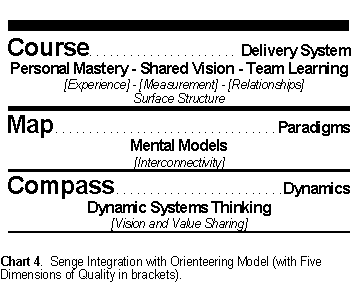 Senge's (1990) five
disciplines correspond with the Five Dimensions of Quality in the Orienteering Model (see
Chart 4). Personal Mastery is an experience level function which takes place at the
personal level. Shared Vision is a measurement function in which we measure our own goals
and desires against others in the community. Team learning is a relationships and systems
function, with each member contributing unique resources to a common endeavor. Mental
Models are the eyes through which we see the world, and they relate directly to paradigms.
By becoming learning organizations, we can begin to see the world through different eyes
and take advantage of structures and dynamics that are inherent in systems, rather than
being controlled by them. Dynamic Systems Thinking is a fifth dimension holistic function
which helps us realize dynamics and principles that are inherent within systems and which
affect the behavior of the system.
Senge's (1990) five
disciplines correspond with the Five Dimensions of Quality in the Orienteering Model (see
Chart 4). Personal Mastery is an experience level function which takes place at the
personal level. Shared Vision is a measurement function in which we measure our own goals
and desires against others in the community. Team learning is a relationships and systems
function, with each member contributing unique resources to a common endeavor. Mental
Models are the eyes through which we see the world, and they relate directly to paradigms.
By becoming learning organizations, we can begin to see the world through different eyes
and take advantage of structures and dynamics that are inherent in systems, rather than
being controlled by them. Dynamic Systems Thinking is a fifth dimension holistic function
which helps us realize dynamics and principles that are inherent within systems and which
affect the behavior of the system.
CONCLUSION
The Map and Compass framework of the Orienteering Model provides insight into the
dynamic and metaphysical planes of a personal or organizational existence. Providing a
comprehensive integration of the teachings of Deming, Covey, and Senge, the Model's
ability to be used at the organizational level as well as the personal level provides
efficiency in personal and organizational development.
ACKNOWLEDGEMENTS
Frank Voehl has contributed immensely to help refine the thinking involved in the Map
and Compass Framework relating to innovation and creativity. Lindon J. Robison's research
in relational economics has provided a foundation for developing the Five Dimension
Concepts and the Compass, Map and Course Framework. The significance of Dr. Robison's
contribution was expressed in a letter from Dr. W. Edwards Deming to one of the authors,
"The work of Dr. Robison teaches me much."
REFERENCE LIST
Barker, Joel A., Future Edge, New York: William Morrow
and Company, Inc., 1992.
Churchill, Neil C. and Lewis, Virginia L. 1983. The Five Stages of Small Business
Growth. Harvard Business Review (May-June): 30 et seq.
Conlin, Elizabeth 1992. Collision Course. Inc. (December): 132-142.
Covey, Stephen R. 1993. Principle-Centered Leadership, New York: Summit Books.
Deming, W. Edwards. 1993. The New Economics. Cambridge, Mass.: Massachusetts
Institute for Technology, Center for Advanced Engineering Study.
Martin, Stein and Voehl, Frank, 1998. Macrologistics Management: A Catalyst for
Organizational Change. St. Lucie Press and APICS.
Posner, Bruce G. and Burlingham, Bo 1988. The Hottest Entrepreneur in America. Inc.
(January): 44-58.
Roberts, Victoria A., 1997. The Pro Bono Passport. Michigan Bar Journal
(August): 778-782.
Senge, Peter M. 1990. The Fifth Discipline. New York: Doubleday/Currency.
Wheatley, Margaret J. 1992. Leadership and the New Science. San Francisco:
Berrett-Koehler Publishers, Inc.
Whyte, David, 1994. The Heart Aroused. New York: Doubleday/Currency.
Winder, Richard E. 1993. Fulfilling Quality's Five Dimensions. In 47th Annual
Quality Congress Transactions. Milwaukee: American Society For Quality Control.
Winder, Richard E. and Judd, Daniel K. 1996. Organizational Orienteering: Linking
Deming, Covey, and Senge in an Integrated Five Dimension Quality Model. In ASQC
Seventh National Quality Management Conference Transactions. American Society for
Quality Control.
Winder, Richard E., Judd, Daniel K., and Robison, Lindon J. "Linking Covey with
Quality: The Five Dimension Denominator," 1995 ASQC Quality Management Conference
Transactions, February 8-10, 1995.
| The Five
Dimensions of Quality by Richard E. Winder,
Lindon J. Robison, and Daniel K. Judd |
| Dimension |
Quality Function Deming Cycle |
Driving Force Stage
of Growth |
Communication Dynamics |
Philosophy |
Psychology Maslow |
Operational Model |
Relationship |
Domain Golden
Rule |
Principal Paradigm |
5th |
Value Sharing ("Delight the Customer")
(1) AIM |
Internal Desire
Fulfillment or Maturity Stage |
Dialogue ("I found
myself completing his sentences.")
Structures |
Charity; Justice and Mercy (Caring) |
Integrative Psychology; Agape (Love)
Actualization |
Leadership (Sharing of Vision, Resources [Human, Information, and Capital
Resources], and Value) |
Dedication; Mutual Participants for common good ("Lose
self: gain all") |
Free Will "Do unto
others as you would have them do unto you." |
Value Sharing ("Delight the Customer") |
4th |
Inter-connectivity (Paradigm Logic)
(2) PLAN |
Inner Drive, Intrinsic Reward, Commitment of the Heart; Ethics;
Moral Values
Growth Stage |
Conscience or Intuition; Paradigm Shift (Empowerment)
Archetypes |
Wisdom; Distributive Justice ("Do
the right thing") |
Conative Psychology (Conscience,
Instinct, Intuition)
Esteem |
E
n
c
o
m
p
a
s
s
e
sA
l
l
F
i
v
e
D
i
m
e
n
s
i
o
n
s |
Principle-Centered Leadership (Mission Development
and Resource Utilization) |
Mutual Promises "Partners"
by agreement; Associates ("Win-Win") |
Partnership "At the end
of the rainbow we'll find our pot of gold." |
Partnership ("Help each other grow") |
3rd |
Relationship (Systems Thinking)
(5) ACT |
Duty; Obligation; Association; Goal
Orientation; Extrinsic Reward
Success Stage |
Consensus; Understanding; Commitment
(Agreement)
Trends |
Passion, Feelings, Sensitivity; Commutative Justice ("Care about it") |
Affective Psychology (Spirit, Emotions)
Social |
U
t
i
l
i
z
e
sF
o
u
r
D
i
m
e
n
s
i
o
n
s |
Management (Structured
Management & Management by Objective) |
Quid Pro Quo; "Parties" to legally
binding contract ("Fair trade") |
Contractual "Go
for the gold." |
Achievement ("Get ahead") |
2nd |
Measurement
(4) STUDY
(CHECK) |
Incentive or Compensation; Control
Survival Stage |
Communication; Discussion (Two-way: "Tell and
Listen") Patterns |
Knowledge; Retributive Justice--Reward ("Do it right") |
Cognitive Psychology (Mind)
Safety |
T
h
r
e
eD
i
m
e
n
s
i
o
n
a
l |
Bureaucracy (Department-alization)
(Two Dimensions) |
Challengers; "Objects" which help achieve goals
("Win-Lose") |
Competitive "He or she
who has the gold rules." |
Competition ("Get ahead of them") |
 1st 1st |
Experience
(3) DO |
Power; Greed; Fear; Apathy
Existence Stage |
Conveyance ("Tell and Sell")
Chaos; Random Forces |
Actions; Retributive Justice--Punishment ("Do it!") |
Behavioral Psychology (Body)
Physiological |
|
Tyranny or Auto-cracy (One Dimen-sion) |
Collusion; Blame; "Victims" of the other party,
who blocks achievement of goals; ("Lose-Lose") |
Enforcement "Bury
it!" ("If I can't have it, he or she can't either.") |
Punishment ("Get back" or "Get even") or
Apathy ("Why bother?") |
| Chart 5.
The Five Dimensions of Quality. |
Copyright 1992, 1993, 1997,
Richard E. Winder, Lindon J. Robison, and Daniel K. Judd |
Rev. Jan. 2, 1998 |
 Our personal and
organizational activities exist on three fundamental planes, or levels of existence: a
physical plane, a metaphysical plane, and a dynamic plane (see Figure 1). The physical
plane is the level of existence we can experience and observe. The metaphysical plane
exists beyond, or transcends, the physical plane and attempts to supply meaning to
physical occurrences. The dynamic plane relates to the physical, social, intellectual, or
moral forces that produce activity or change in a system. We observe this activity or
change at the physical level, and we interpret it at the metaphysical level. While we are
generally aware of the physical, we are often less aware of the metaphysical meaning and
dynamic forces. Yet those two planes are integrally connected with the physical existence
and have a very real impact on it. If these planes are not understood, then unexplained,
unintended, and even unknown consequences may occur at the physical level.
Our personal and
organizational activities exist on three fundamental planes, or levels of existence: a
physical plane, a metaphysical plane, and a dynamic plane (see Figure 1). The physical
plane is the level of existence we can experience and observe. The metaphysical plane
exists beyond, or transcends, the physical plane and attempts to supply meaning to
physical occurrences. The dynamic plane relates to the physical, social, intellectual, or
moral forces that produce activity or change in a system. We observe this activity or
change at the physical level, and we interpret it at the metaphysical level. While we are
generally aware of the physical, we are often less aware of the metaphysical meaning and
dynamic forces. Yet those two planes are integrally connected with the physical existence
and have a very real impact on it. If these planes are not understood, then unexplained,
unintended, and even unknown consequences may occur at the physical level. The Map and
Compass Framework moves us from an analysis mode to an application mode (see Figure 2). It
helps us not only evaluate existing conditions, but permits us (with an understanding of
those conditions) to develop innovative prospective applications that incorporate our
learning.
The Map and
Compass Framework moves us from an analysis mode to an application mode (see Figure 2). It
helps us not only evaluate existing conditions, but permits us (with an understanding of
those conditions) to develop innovative prospective applications that incorporate our
learning.  Dynamics provide
overriding purposes, or unifying benefits which can guide personal and organizational
development. Intuitive response to needs-fulfillment and effective response to relational
dynamics can build a much more solid foundation for "sustaining membership" of
customers and employees than reaction to these dynamics. For example, Jim Graley, who
owned a typical auto body repair shop which was unfriendly to women (see Figure 3),
responded to the dynamic that women are the key decision makers in 70% of new car
purchases by modifying his systems and processes to attract the business of women (see
Figure 4), tripling his sales in one year (from $525,000 to $1.6 million). (Conlin, 1992).
Dynamics provide
overriding purposes, or unifying benefits which can guide personal and organizational
development. Intuitive response to needs-fulfillment and effective response to relational
dynamics can build a much more solid foundation for "sustaining membership" of
customers and employees than reaction to these dynamics. For example, Jim Graley, who
owned a typical auto body repair shop which was unfriendly to women (see Figure 3),
responded to the dynamic that women are the key decision makers in 70% of new car
purchases by modifying his systems and processes to attract the business of women (see
Figure 4), tripling his sales in one year (from $525,000 to $1.6 million). (Conlin, 1992).
 Since vision is based on
linking needs with resources, and since needs and resources are in a constant state of
change, vision itself is always changing. Consequently, it is important to always monitor
the dynamics to ensure that systems and processes are still in alignment with and support
the unifying purposes of the organization. Moreover, the organization must ensure that its
systems and processes nurture relationships with key constituents, including customers,
employees, and owners. If those constituents are part of the vision process, and are
included in the unifying purposes used by the organization, then it is likely that the
systems and processes which are developed will incorporate their needs.
Since vision is based on
linking needs with resources, and since needs and resources are in a constant state of
change, vision itself is always changing. Consequently, it is important to always monitor
the dynamics to ensure that systems and processes are still in alignment with and support
the unifying purposes of the organization. Moreover, the organization must ensure that its
systems and processes nurture relationships with key constituents, including customers,
employees, and owners. If those constituents are part of the vision process, and are
included in the unifying purposes used by the organization, then it is likely that the
systems and processes which are developed will incorporate their needs.  The Orienteering Model
(Winder and Judd, 1996) presupposes a flow to the interaction of dynamics, metaphysics,
and physical activities (see Figure 5). This flow follows Deming's Aim-Plan-Do-Study-Act
Cycle (Deming, 1993, did not specifically add "aim" to the Plan-Do-Study-Act
Cycle, but indicated that every system must have an aim; the addition of
"aim" to this cycle brings it into complete alignment with the Five Dimensions
of Quality and the Orienteering Model). The flow model is comprehensive in design, but may
be incomplete in application. For example, an organization may design a system and put it
into place without piloting it or testing it to ensure their assumptions about the
dynamics were correct (this is the Plan-Act cycle). Or, an organization may simply
discover that what it has done (without any planning) actually works, and then implement
it (the Do-Study-Act cycle).
The Orienteering Model
(Winder and Judd, 1996) presupposes a flow to the interaction of dynamics, metaphysics,
and physical activities (see Figure 5). This flow follows Deming's Aim-Plan-Do-Study-Act
Cycle (Deming, 1993, did not specifically add "aim" to the Plan-Do-Study-Act
Cycle, but indicated that every system must have an aim; the addition of
"aim" to this cycle brings it into complete alignment with the Five Dimensions
of Quality and the Orienteering Model). The flow model is comprehensive in design, but may
be incomplete in application. For example, an organization may design a system and put it
into place without piloting it or testing it to ensure their assumptions about the
dynamics were correct (this is the Plan-Act cycle). Or, an organization may simply
discover that what it has done (without any planning) actually works, and then implement
it (the Do-Study-Act cycle).  As near as the authors
can tell, the Orienteering model and its Map & Compass framework is a universal model
that provides a comprehensive tool for creative personal and organizational development.
Its power comes from the fact that it is based on fields of meaning related to the Five
Dimensions of Quality and the Compass, Map, and Course flow structure of those dimensions.
As a consequence, the model can be used repetitively in multiple iterations, simply by
supplying other words or concepts within the field of meaning.
As near as the authors
can tell, the Orienteering model and its Map & Compass framework is a universal model
that provides a comprehensive tool for creative personal and organizational development.
Its power comes from the fact that it is based on fields of meaning related to the Five
Dimensions of Quality and the Compass, Map, and Course flow structure of those dimensions.
As a consequence, the model can be used repetitively in multiple iterations, simply by
supplying other words or concepts within the field of meaning.  The accuracy of the
diagnosis will have an impact on the value of the treatment, which also relies on the
medical expertise of the doctor to "Map" a treatment that (based on the doctor's
understanding of the dynamics) is geared toward assisting in the healing process, at least
for curable diseases or injuries. Finally, it takes actual implementation of the treatment
plan (traveling the Course) to determine the response of the patient and to assess whether
the doctor's assessment of the injury/illness and the treatment were effective.
The accuracy of the
diagnosis will have an impact on the value of the treatment, which also relies on the
medical expertise of the doctor to "Map" a treatment that (based on the doctor's
understanding of the dynamics) is geared toward assisting in the healing process, at least
for curable diseases or injuries. Finally, it takes actual implementation of the treatment
plan (traveling the Course) to determine the response of the patient and to assess whether
the doctor's assessment of the injury/illness and the treatment were effective.
 The models developed
by Deming, Covey, and Senge are complete models which represent some of the best thinking
of the Twentieth Century related to organizational development. Their models can be used
effectively in an organization, and in fact they are used pervasively in many
organizations. Application of any one of the models can produce desirable results.
The models developed
by Deming, Covey, and Senge are complete models which represent some of the best thinking
of the Twentieth Century related to organizational development. Their models can be used
effectively in an organization, and in fact they are used pervasively in many
organizations. Application of any one of the models can produce desirable results.  Deming's
focus was on the physical level--the course. His interest was in the delivery system and
how understanding systems and variation can assist in knowing the capacity of the system.
Covey's focus is on the metaphysical--the map--including the principles of human
relationships, and how the improvement of those relationships can improve the
organization. Senge's focus is on the compass--the unseen but very powerful dynamics
underlying systems. A focus on these dynamics and the structures that cause activity
within a system can assist in the strategic planning process in determining what markets
should be pursued and what skills should be developed. It is our consciousness of
the dynamic context of our environment that permits us to shape the conduct
of our systems.
Deming's
focus was on the physical level--the course. His interest was in the delivery system and
how understanding systems and variation can assist in knowing the capacity of the system.
Covey's focus is on the metaphysical--the map--including the principles of human
relationships, and how the improvement of those relationships can improve the
organization. Senge's focus is on the compass--the unseen but very powerful dynamics
underlying systems. A focus on these dynamics and the structures that cause activity
within a system can assist in the strategic planning process in determining what markets
should be pursued and what skills should be developed. It is our consciousness of
the dynamic context of our environment that permits us to shape the conduct
of our systems. It is said that we can learn
from experience, but the truth is that our learning is not based on experience itself, but
our reflection on experience. Moreover, it is knowledge of the dynamics underlying systems
that gives us the ability to predict the future with some certainty. Systems are a
relationships and systems thinking function. They permit standardizing the course so that
it can be repeated on a consistent basis. Psychology is a paradigm function. It is a shift
in paradigms which will permit an organization to see the difference between intrinsic and
extrinsic rewards, and the residual effects of each type of reward system.
It is said that we can learn
from experience, but the truth is that our learning is not based on experience itself, but
our reflection on experience. Moreover, it is knowledge of the dynamics underlying systems
that gives us the ability to predict the future with some certainty. Systems are a
relationships and systems thinking function. They permit standardizing the course so that
it can be repeated on a consistent basis. Psychology is a paradigm function. It is a shift
in paradigms which will permit an organization to see the difference between intrinsic and
extrinsic rewards, and the residual effects of each type of reward system.  Senge's (1990) five
disciplines correspond with the Five Dimensions of Quality in the Orienteering Model (see
Chart 4). Personal Mastery is an experience level function which takes place at the
personal level. Shared Vision is a measurement function in which we measure our own goals
and desires against others in the community. Team learning is a relationships and systems
function, with each member contributing unique resources to a common endeavor. Mental
Models are the eyes through which we see the world, and they relate directly to paradigms.
By becoming learning organizations, we can begin to see the world through different eyes
and take advantage of structures and dynamics that are inherent in systems, rather than
being controlled by them. Dynamic Systems Thinking is a fifth dimension holistic function
which helps us realize dynamics and principles that are inherent within systems and which
affect the behavior of the system.
Senge's (1990) five
disciplines correspond with the Five Dimensions of Quality in the Orienteering Model (see
Chart 4). Personal Mastery is an experience level function which takes place at the
personal level. Shared Vision is a measurement function in which we measure our own goals
and desires against others in the community. Team learning is a relationships and systems
function, with each member contributing unique resources to a common endeavor. Mental
Models are the eyes through which we see the world, and they relate directly to paradigms.
By becoming learning organizations, we can begin to see the world through different eyes
and take advantage of structures and dynamics that are inherent in systems, rather than
being controlled by them. Dynamic Systems Thinking is a fifth dimension holistic function
which helps us realize dynamics and principles that are inherent within systems and which
affect the behavior of the system.



 1st
1st